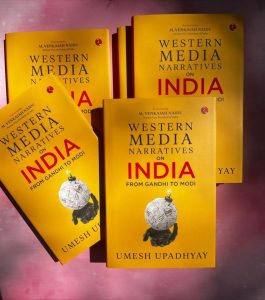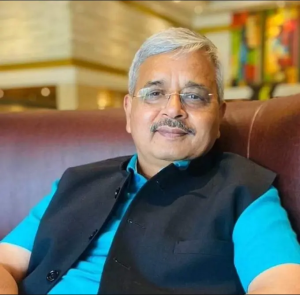A Book Born from Decades of Insight
Western Media Narratives on India: From Gandhi to Modi is not merely a book; it is a meticulously researched chronicle that traces the evolution of Western media portrayals of India from the pre-Independence era to the present day under Prime Minister Narendra Modi. The cover art—a gloved hand holding a globe made of newspaper fragments with a lit fuse—symbolizes the explosive potential of media narratives to shape global perceptions. Upadhyay’s work delves into how these narratives have often been skewed, reflecting biases rooted in colonial legacies, cultural imperialism, and geopolitical agendas. From the underreported atrocities of the Jallianwala Bagh massacre to exaggerated predictions of India’s collapse during the COVID-19 pandemic, the book uncovers a pattern of selective storytelling that undermines India’s achievements and potential.

Upadhyay’s multidisciplinary approach, drawing from media studies, history, sociology, and political science, equips readers with the tools to decipher these narratives. Endorsements from figures like Harivansh, Deputy Chairman of the Rajya Sabha, and bestselling author Amish Tripathi underscore the book’s credibility and readability. Harivansh notes that the book exposes how Western media has historically “boxed India’s place in the world,” while Tripathi praises its calm, clinical analysis as a must-read for those frustrated with Western media’s impact on India’s international relations.
The Context of Its Creation
Upadhyay was actively promoting Western Media Narratives in the months leading up to his death, engaging with audiences through interviews and social media. His X post from March 6, 2024 (Post ID: 1765376382303977828), announcing the book’s release, reflects his excitement and dedication: “It’s been an absolute honor to delve into decades of research, uncovering the biases that have shaped how India is portrayed globally.” Videos on YouTube (e.g., https://www.youtube.com/watch?v=9wUaTllQMGM and https://www.youtube.com/watch?v=lySJD_Re61c) capture his readiness to discuss the book, offering insights into his passion for challenging dominant narratives.
Tragically, on September 1, 2024, at the age of 66, Upadhyay succumbed to injuries sustained in a fall from the fourth floor of an under-construction building in Vasant Kunj, Delhi, while inspecting renovations. This accident cut short a career marked by intellectual rigor and a commitment to truth.
The Battle of Narratives in the Present Era
In 2025, the importance of Western Media Narratives on India has only grown, as the battle of narratives has become a defining challenge for both the Indian Central Government and the Western media. For the government, shaping a positive global image is crucial as India emerges as a global economic and political powerhouse. The Modi administration has faced scrutiny over issues like dissent suppression, economic policies, and social challenges—narratives often amplified by Western outlets to fit a preconceived mold of a developing nation struggling with democracy. Upadhyay’s book provides a historical lens to contextualize these portrayals, revealing how such biases date back to colonial times and persist as tools of influence.

Conversely, Western media faces its own challenge: maintaining credibility in an era of digital democratization and competing narratives. The rise of Indian media, social platforms like X, and alternative voices has disrupted the monopoly Western outlets once held over global storytelling. Upadhyay’s work exposes the stakes involved—credibility is at risk if these outlets fail to adapt their approach, as Harivansh warns in his review. The book’s relevance lies in its call for a balanced dialogue, urging both sides to move beyond stereotypes and engage with India’s multifaceted reality.
The Central Government’s Narrative Challenge
For the Indian Central Government, the narrative battle is multifaceted. On one hand, it must counter Western media’s focus on negative tropes—poverty, corruption, and human rights concerns—while highlighting achievements like digital innovation, space exploration, and economic growth. On the other, it must navigate internal dissent and global perceptions of its policies, a tension Upadhyay addresses through his analysis of media’s role in shaping national identity. The government’s push for a “New India” narrative clashes with Western frameworks that often frame India as a perpetual underdog or authoritarian state, a dichotomy the book dissects with evidence from news articles, speeches, and surveys.
This challenge is not merely about image but influence. As India seeks a permanent seat on the UN Security Council or leadership in global forums, the narrative war determines its legitimacy. Upadhyay’s book equips policymakers with the historical context to anticipate and counter these biases, making it an essential tool in the government’s diplomatic arsenal. In the ten months since his passing, the government’s narrative efforts have intensified, underscoring the timeliness of his insights
.
The Western Media’s Dilemma
Western media, meanwhile, grapples with its legacy of Eurocentric reporting. Upadhyay’s analysis of historical events-like the Manchester Guardian’s understated coverage of Jallianwala Bagh-illustrates a pattern of downplaying India’s struggles while amplifying its flaws. In the digital age, this approach is increasingly untenable as Indian voices challenge these narratives directly. The book’s critique of cultural imperialism resonates today, as Western outlets face accusations of agenda-driven reporting on issues like Kashmir or the Citizenship Amendment Act. The challenge for Western media is to evolve, but as Upadhyay suggests, this requires acknowledging past biases—a step many are reluctant to take.
A Legacy Unfinished
Umesh Upadhyay’s death on September 1, 2024, has left his work unfinished, yet Western Media Narratives on India stands as a beacon for future discourse. The book’s neglect in the ten months since his demise is a poignant reminder of how quickly intellectual contributions can fade without sustained engagement. However, its relevance endures, particularly as narrative battles intensify. The Central Government’s efforts to project a global image, coupled with Western media’s struggle to retain influence, mirror the themes Upadhyay explored. His call for readers to “uncover the truth behind the headlines” remains a rallying cry.
Western Media Narratives on India: From Gandhi to Modi is more than a historical analysis; it is a roadmap for navigating the narrative wars of the 21st century.
In an era where information is power, Upadhyay’s work keeps a finger on the pulse of time, offering insights that are as critical today as they were in 2024. For the Indian Central Government, it is a strategic guide to countering global biases; for Western media, a mirror to reflect on its shortcomings. As we commemorate Upadhyay’s legacy on this July morning in 2025—nearly ten months after his passing on September 1, 2024, at age 66—let us not forget his book—a vital tool in understanding and shaping the narratives that define India’s place in the world.





